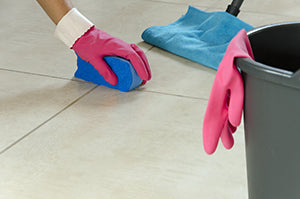
Grout turning white is usually due to efflorescence, which the movement of salt or minerals to the surface of porous material (such as your grout) and forms a whitish coating. This can happen in a few different ways. The most common reason is moisture from the ground below the slab, but grout may also turn white from the rain in outdoor installations, or in rare cases from water used to clean the floor. Another possibility is that grout containing polymer was used and exposed to too much water before the polymers had a chance to combine. According to the Tile Council of North America (TCNA), “grout mixed with too much water or cleaned too soon, or cleaned with excess water can cause the polymer to migrate to the surface. In many cases (but not all), these polymers are white in color. When the excess water evaporates, the white polymer is exposed.” Finally, in less common cases, grout may turn white due to cleaning agents not being fully removed leaving a detergent residue that builds up over time. Most times residue from cleansers isn’t clearly visible, but it can combine with light-colored soil and cause a coating over the grout because of the grout’s porosity.
How Can I Fix Efflorescence?
Let’s start with the not so great news, the most effective ways to address efflorescence are done prior to the tile floor being installed. If there is a continuous emergence of moisture detected on the slab, the tile contractor should consider a vapor equalization membrane or remediation steps as the TCNA states. After tiling, a good step is to apply a penetrating
vapor-permeable sealer which can help delay the rate of efflorescence. But since you’re reading this article, we’re going to guess that you’ve already gotten past that opportunity. So now that your tile floor is already installed and your grout has turned white, let’s take a look at how to best address it. The TCNA suggests, “Generally efflorescence is removed with an acid. However, grout manufacturers do not advocate the use of acids because they attack the cement in the grout. Used judiciously though, this can be a highly effective way of removing efflorescence. Extreme care should be used to protect the person applying the acid and surrounding fixtures. Also, acid that is too strong can strip some color out of grout (which is also undesirable) and acid generally cannot be used if acrylic sealers have already been applied to the grout.” At D&B Tile, we recommend that you used a licensed professional for this type of work. At our stores, we carry
Aqua Mix EFF-EX or
Aqua Mix Heavy-Duty Tile & Grout Cleaner which should remove the white residue.
How Do I Fix Polymer Residue?
“For removing a whitish residue from polymer migration, solvents or strong cleaners are needed. As there are many different polymers that could have been used in the grout, any one cleaner may have more or less efficacy,” the TCNA recommends. You can visit any of our nine South Florida D&B Tile showrooms and talk to our tile experts who will be happy to help you determine which solvent is best for your application.
How Do I Fix Detergent Residue?
As this builds up over time, the detergent residue can be annoying, but a little elbow grease will go a long way. D&B Tile recommends you start with a good brushing of the grout and multiple rinses of hot, clean water. Remember, it is very important to remove all the dirty water on the floor and the best way to accomplish that is through a good shop vacuum. But if you don’t have one, multiple rinses will do the job too. Remember, D&B Tile Distributors’ goal is to help you through your project from beginning-to-end while ensuring you get a beautiful result. Our team of tile experts goes through consistent training to stay up-to-date on the latest techniques, products, and solutions. We are here to help you, so always feel free to contact us with any of your questions or stop by one of our showrooms and we’ll walk you through the best options.
Source:TCNA Tile
 Grout turning white is usually due to efflorescence, which the movement of salt or minerals to the surface of porous material (such as your grout) and forms a whitish coating. This can happen in a few different ways. The most common reason is moisture from the ground below the slab, but grout may also turn white from the rain in outdoor installations, or in rare cases from water used to clean the floor. Another possibility is that grout containing polymer was used and exposed to too much water before the polymers had a chance to combine. According to the Tile Council of North America (TCNA), “grout mixed with too much water or cleaned too soon, or cleaned with excess water can cause the polymer to migrate to the surface. In many cases (but not all), these polymers are white in color. When the excess water evaporates, the white polymer is exposed.” Finally, in less common cases, grout may turn white due to cleaning agents not being fully removed leaving a detergent residue that builds up over time. Most times residue from cleansers isn’t clearly visible, but it can combine with light-colored soil and cause a coating over the grout because of the grout’s porosity.
Grout turning white is usually due to efflorescence, which the movement of salt or minerals to the surface of porous material (such as your grout) and forms a whitish coating. This can happen in a few different ways. The most common reason is moisture from the ground below the slab, but grout may also turn white from the rain in outdoor installations, or in rare cases from water used to clean the floor. Another possibility is that grout containing polymer was used and exposed to too much water before the polymers had a chance to combine. According to the Tile Council of North America (TCNA), “grout mixed with too much water or cleaned too soon, or cleaned with excess water can cause the polymer to migrate to the surface. In many cases (but not all), these polymers are white in color. When the excess water evaporates, the white polymer is exposed.” Finally, in less common cases, grout may turn white due to cleaning agents not being fully removed leaving a detergent residue that builds up over time. Most times residue from cleansers isn’t clearly visible, but it can combine with light-colored soil and cause a coating over the grout because of the grout’s porosity.

 Grout turning white is usually due to efflorescence, which the movement of salt or minerals to the surface of porous material (such as your grout) and forms a whitish coating. This can happen in a few different ways. The most common reason is moisture from the ground below the slab, but grout may also turn white from the rain in outdoor installations, or in rare cases from water used to clean the floor. Another possibility is that grout containing polymer was used and exposed to too much water before the polymers had a chance to combine. According to the Tile Council of North America (TCNA), “grout mixed with too much water or cleaned too soon, or cleaned with excess water can cause the polymer to migrate to the surface. In many cases (but not all), these polymers are white in color. When the excess water evaporates, the white polymer is exposed.” Finally, in less common cases, grout may turn white due to cleaning agents not being fully removed leaving a detergent residue that builds up over time. Most times residue from cleansers isn’t clearly visible, but it can combine with light-colored soil and cause a coating over the grout because of the grout’s porosity.
Grout turning white is usually due to efflorescence, which the movement of salt or minerals to the surface of porous material (such as your grout) and forms a whitish coating. This can happen in a few different ways. The most common reason is moisture from the ground below the slab, but grout may also turn white from the rain in outdoor installations, or in rare cases from water used to clean the floor. Another possibility is that grout containing polymer was used and exposed to too much water before the polymers had a chance to combine. According to the Tile Council of North America (TCNA), “grout mixed with too much water or cleaned too soon, or cleaned with excess water can cause the polymer to migrate to the surface. In many cases (but not all), these polymers are white in color. When the excess water evaporates, the white polymer is exposed.” Finally, in less common cases, grout may turn white due to cleaning agents not being fully removed leaving a detergent residue that builds up over time. Most times residue from cleansers isn’t clearly visible, but it can combine with light-colored soil and cause a coating over the grout because of the grout’s porosity.

